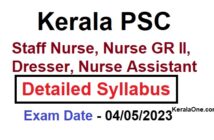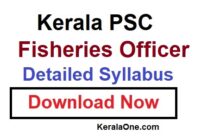Deprecated: Creation of dynamic property InsertPostAds::$settings is deprecated in /home4/keralaon/public_html/wp-content/plugins/insert-post-ads/insert-post-ads.php on line 427
Kerala PSC Food Safety Officer Syllabus:- Are preparing for Food Safety Officer exam conducted by Kerala Public Service Commission. Here we are providing the detailed syllabus for Food Safty Officer examination. The Kerala PSC Decided to conduct the Food Safety Officer examination on 20.05.2020. Candidates can all details about KPSC Food Safety Officer examination such as Detailed Syllabus, Exam Pattern, exam date, date to submitting confirmation, hall ticket availability etc. here.
Content
- Kerala PSC Food Safety Officer Exam Details
- Food Safety Officer Exam Pattern
- Food Safety Officer Syllabus
- Food Safety Officer Detailed Syllabus PDF File
- Food Safety Officer Exam Date and Confirmation Date
- Download Food Safety Officer Hall Ticket
- Food Safety Officer Previous Question Papers
Kerala PSC Food Safety Officer Exam Details
| Kerala PSC Exam | Details |
|---|---|
| Post Name | Food Safety Officer |
| Department | Food Safety |
| Organization | Kerala Public Service Commission |
| Category Number | 499/2019 |
| Exam Date | 29/09/2020 |
| Notification | Click Here |
KPSC Food Safety Officer Exam Pattern
The Kerala PSC released the Food Safety Officer exam pattern 2020. The examination will be in objective type multiple choice only with 1-hour 15-minute duration. A total of 100 questions will be in a question paper and each question carries one mark. The medium of questions shall be in English only.
| Event | Details |
|---|---|
| Total Marks | 100 |
| Duration | 1 Hour 15 Minutes |
| Medium of Question | English |
| Exam Type | OMR/ Online (Objective type Multiple Choice) |
KPSC Food Safety Officer Syllabus
The Kerala PSC Food Safety Officer examination contains 10 main topics. Food Safety Officer Detailed Syllabus such as Maine Topics and the subtopics is as follows.
Food Technology
Principles and methods of food preservation – Heat processing, pasteurization,
canning, dehydration, freezing, freeze-drying, fermentation, microwave, irradiation and chemical preservatives – Aseptic preservation, hurdle technology, hydrostatic pressure technology, microwave processing, microfiltration, bactofugation, ultra high voltage electric fields, pulsed electric fields, high-pressure processing, irradiation, thermosensation, ohmic heating, dielectric heating, infrared, induction heating, antibacterial and bacteriocins. Food fortification. Food additives. Classification, composition, manufacture, packaging, storage and defects of tomato products, other convenience foods from fruits and vegetables, beverages – tea, cocoa and coffee – pickles, chutney, sauces, spices, jam, Jelley, marmalade, health drinks, restructured fruits and vegetables, preparation of fruits and vegetables, minimally processed products and Individually Quick Freeze products. Milling, processing, composition, structure, product development and byproduct utilization of cereals, pulses, millets and oilseeds. Antinutritional factors. Instant ready mixes. Packaging – materials and methods. Nutritional labelling of food. Quality control – systems and tools. Food plant sanitation. Food hygiene. Environment and waste management. Total quality management, good management practices, HACCP and codex Alimentarius commission.
Dairy Technology
Composition of milk- Physicochemical properties of milk- milk hygiene- milk microbiology – Market milk: a collection of milk- cooling and transportation– filtration/clarification- standardization- homogenization – pasteurization- UHT – sterilization- packaging. Tests for milk quality and detection of adulterants- dairy plant and equipment hygiene and sanitation. Definition, classification, composition, outline of manufacture, packaging, storage and defects of the following milk products: Cream, Malai, Dahi /Curd, yoghurt, Channa / Paneer, Cheese, Ice cream, Frozen desserts, Evaporated milk, Condensed milk, Milk powder, Butter, Ghee, Chakka and Shrikhand, Indigenous milk products. Foods for infant nutrition . Whey products, Edible casein products.
Veterinary Sciences
Standards for organization and layout of abattoirs, handling and transport
of meat animals including poultry. Antemortem and post mortem examination. Scientific slaughtering and dressing of carcasses. Evaluation, grading and fabrication of dressed carcasses including poultry. Fraudulent substitution of meat, preservation of meat and aquatic foods. Ageing of meat. Packaging of meat and meat products. Physico-chemical and microbiological quality of meat and aquatic food and food products. Organic meat food products. Food products of genetically modified animals and marine origin. Meat as a source of disease transmission. Physical, chemical nutritional and functional characteristics of egg. Processing of Egg and egg products. Preservation and storage of egg.
Food Safety and Allied Laws
The Food Safety and Standards Act, 2006; Rules and Regulations: Definitions –
Authorities and Officers – Constitution, Functions and Powers –General Provisions as to Articles of Food, Ch. IV, SS.19 to 24- Prohibition Orders- Procedure for Investigation and Launching Prosecutions – Analysis of Food – Offences and Penalties – Defences – Adjudication. Criminal Procedure Code, 1973: Definitions- Cognizance of offences by Magistrate, S.190 – Complaints to Magistrate, SS. 200 to 203 – Trial of Sessions cases, SS. 225 to 237 – Trial of Warrant Cases, SS.238 to 250- Trial of Summons Cases, SS. 251 to 259 – Summary Trial, SS. 260 to 265- Appeal, SS. 372 to 394 –Bail and Bonds, SS. 436 to 450. Indian Evidence Act, 1872: Definitions- Expert Evidence, S.45 – Documentary Evidence, SS. 61 to 78.
Nutritional Biochemistry and Food Analysis
Chemical composition of food: Carbohydrates, lipids, proteins, fibre, vitamins,
and minerals – characteristics, sources, physiological and biochemical functions, daily requirement, digestion and absorption. The biological value of proteins (BV), Protein efficiency ratio (PER), Digestibility coefficient, Net protein Utilization, Net Protein Ratio(NPR), Chemical Score, Free Radicals and Antioxidants. Energy value of foods, Respiratory Quotient (RQ), Determination of Basal Metabolic Rate (BMR), Determination of energy metabolism during work, Energy expenditure for various types of activities, Recommended Daily Allowance (RDA), Specific Dynamic Action (SDA) of foods, Balanced diet formulation. Analytical techniques used in the detection of adulteration of food: Principle, procedure and detectors of chromatographic techniques (Column,
paper, TLC, HPLC and GC), Spectroscopic techniques (IR, UV, MS and AAS). Food Analysis – moisture content, ash, fat, carbohydrate, crude fibre, crude protein, sodium, potassium, calcium, and phosphates. Food adulteration: common adulteration, contamination and pesticide analysis. Oils and Fats – Iodine value and saponification value.
Microbiological, Biotechnological and Medical aspects
Microscopy, staining and culture techniques, sterilization techniques, culture media, factors influencing microbial growth, growth curve, thermal death time and thermal death points, D-value, Z- value. Sources of microorganisms in food, perishable, semi perishable and non-perishable foods, intrinsic and extrinsic parameters influencing microbial content of food, Food spoilage-types, causes and indications. Control of spoilage-pre-harvesting and post-harvesting food processing. Food Borne Diseases: Definition, Classification ( Foodborne intoxications & Foodborne infections), neurolathyrism, aflatoxins, Ergotism, Epidemic dropsy, Typhoid fever, Salmonellosis, Staphylococcal intoxication, Botulism, Bacillus cereus food poisoning, E.coli diarrhoea, Cholera, Shigellosis, Brucellosis, Food poisoning: Types of food poisoning, method of investigation of food poisoning, prevention and control- food sanitation, refrigeration, surveillance. Food handlers: a medical examination of food handlers, infections
transmitted by food handlers, education of food handlers. Adulteration of foods: Health hazards. Sanitation of eating places: minimum standards, storage of uncooked foodstuffs, waste disposal, water supply and washing facilities. Fermented foods- types, production, organisms involved, advantages and disadvantages, spoilage of fermented foods. Microbiological analysis of food and water- qualitative and quantitative, indicator organisms, coliforms, detection of pathogens, molecular techniques for detection of microbes. Microbiological standards of food and water. Water purification for domestic and municipal purposes. Sewage treatment. Application of enzymes in the food industry, production of food flavour and colour. Enzyme immobilization and applications. Use of amylase, invertase, protease, pectinase and cellulase in food industries. Bioreactors. Single-Cell Proteins. Molecular detection of food contamination. Genetically modified food and labelling.
Agricultural Sciences
Post-harvest handling: Physiology of maturity, ripening and senescence in
cereals, pulses, fruits and vegetables. Maturity indices and harvesting of vegetables. Post-harvest losses, phases of loss and measures to reduce the losses. Fruits and vegetable cleaning and grading, methods of grading, equipment for grading of fruits and vegetables. Storage, grain storage, types of storage structures- traditional, improved and modern storage structures. Size reduction- Principles and equipment for size reduction. Edible mushrooms. Stored product pests and their management – preventive and curative methods. Rodent management: principles and methods of control; Rodenticides – acute poisons, chronic poisons, fumigants. Fumigation, baits, baiting and rat-proofing.
Constitution and Civil Rights
Constituent Assembly – Preamble – Fundamental Rights – Directive principles – Fundamental Duties – Citizenship – Constitutional Amendments – Panchayath Raj – Constitutional Institutions and their Functions – Emergency- Union List- State List – Concurrent List.
Mental Ability and Test of Reasoning
Calculation & Logic – Coding & Decoding- Classification- Synonym- AntonymLetter & Number Series- Odd Man Out- Analogy- Common Sense Test- Alphabetical Arrangement of Words- Date and Calendar- Sense of Direction- Etc.
General English
Grammar – Agreement of Subject and Verb – Confusing Adjectives and Adverbs – Comparison of Adjectives – Correct usage of Articles – Prepositions – Direct and Indirect Speech – Active and Passive Voice – Correction in Sentences – etc. Vocabulary – Gender – Singular and Plural – Synonyms – Antonyms – One-word Substitutes – Problem concerning words – Idioms and their meanings – etc.
Kerala PSC Food Safety Officer Detailed Syllabus PDF File
Food Safety Officer Exam Date and Confirmation Date
Kerala Public Service Commission going to release the examination date and the food safety officer examination is expected on 20.05.2020. Candidates who are applied for the Food Safety Officer vacancies have to submit the confirmation before the last date prescribed by the last date. Only candidates who submit the confirmation successfully can attend the examination. The examination date and confirmation date for the written examination are as follows.
| Event | Date |
|---|---|
| Confirmation submitting date starts from | 21/02/2020 |
| Last date to submitting the confirmation | 11/03/2020 |
| Exam Date | 29/09/2020 |
Download Food Safety Officer Hall Ticket
Candidates who submit the confirmation for the written examination can download the Food Safety Officer Admission Ticket through their One Time Registration Profile. The admission ticket will be from 06/05/2020 in your OTR profile. Candidates are not allowed to enter into the exam centre without hall ticket. Kerala PSC requested to carry any of your photo identity proof with the hall ticket.
Kerala PSC Food Safety Officer Previous Question Papers
Candidates who are preparing for Kerala PSC Food Safety Officer examination can get solved Food Safety Officer previous question paper here. To download the question papers with answers click on the below-given button




